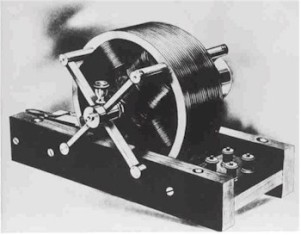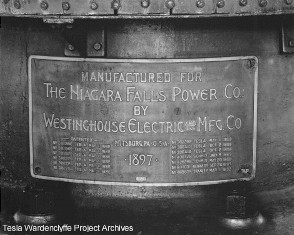AC technology development
AC of magnetoelectric machines were able to get back in the 30 -. Of the XIX century, but in practice, this kind of power has been recognized and appreciated until much later. Until the mid-70s for AC generators treated episodically. The impetus for the development of this type of electric cars, as already noted, was the invention Yablochkov electric candles.
By the mid-80s were suitable for practical purposes alternators thanks to numerous improvements made Yablochkov, grams and British scientists and engineers W. Thomson (Lord Kelvin), C. Ferranti, Mordeem B., D. Gordon.

In 1870 - 1880-ies of the transformer has been created. First came the induction coils Yablochkov (even with open magnetic system), which served, as already noted, for "crushing" of electric energy in lighting installations. Then work JF Usagina, Golyara L., E. D. Gibbs and other inventors ever closer to the type of device that can be called a transformer in the modern sense.
In 1884, the British John and Edward Hopkinson for the first time created a design with a closed magnetic system, in 1885 the Hungarian electrical engineer M. Dery and independently by C. Ferranti in the UK and in the US of A. Kennedy proposed a parallel connection of transformers in the supply line.
The unit closed a laminated magnetic core developed Hungarian electrical engineers A. Fortunately, M. Dery and K. Tsipernovski and American engineer W. Stanley. In the creation of reliable high-power power transformers has become essential as proposed in the late 80-ies D. Swinburne oil cooling.
Already the first transformers and generators are single phase alternating current, has a sufficiently high operational parameters, allowed to carry out in 1884, the test transmission of electricity over a distance. An important event in the history of the development of alternating current technology has become the first major single-phase AC power, built in 1885 in Dentforde (near London) for street lighting in the western part of the city: the power of 1000 kW, the transmission distance of 12 km at a voltage of 10 kV. Large single-phase AC station in 1887 were built in Russia in Odessa and Tsarskoye Selo.

Operating experience of the first stations have shown great AC possibilities for economical transmission over a distance of energy, but found and its main flaw: the limitations of use in the field of lighting, as fuel-efficient single-phase electric current does not exist. AC victory began with the development of new physical principles of electric motors - a rotating magnetic field.
The phenomenon of the rotating magnetic field was discovered in 1885 by the Italian physicist G. Ferraris. He originally came to the wrong conclusion that the electric motor, which was built on this principle, the efficiency can not be higher than 50%. This weakened his interest in the discovery of the phenomenon.
Having studied the rotating magnetic field of the Yugoslav scientist and inventor Nikolai Tesla found that using two or more alternating currents shifted in phase, it is possible to obtain a rotating magnetic field and create on this principle, the electric motor. Tesla also concluded that the feasibility of obtaining the required phase difference using a special generator.
In the years 1887 -1888. he created the schema and model multiphase motors and generators, among them two-phase induction motor and generator - it is a workable system. It has been recognized but not widely spread, as has been less perfect compared to the associated three-phase current system created in Europe. The project has built Tesla largest for the time of two-phase Niagara hydroelectric power and some more installations in the United States and Western Europe.

By the 1887-1889 biennium. are trying to engineer the German FA Hazelvandera and American Charles Bradley to get generators and engines approaching the associated three-phase system.
In creating reasonably practicable engine three-phase alternating current primary role belonged to the Russian engineer MO Dolivo-Dobrovolsky.
In 1889 he created the design of the three-phase asynchronous motor with squirrel-cage rotor. The engine had undoubted merits: their own came in rotation when the voltage without requiring special pathogen as synchronous motors, or additional engine for acceleration as two-phase motors, the power is carried out by means of three wires attached to the three ends of the stator windings instead of four wires at two-phase system. One of its major advantages over DC machines was the lack of sliding contacts, and hence the brush sparking on the collector.
For powerful engines Dolivo-Dobrovolsky in 1890 he developed the design of the rotor with the phase winding and the slip ring. Three-phase induction motors are widely used in the industry to date, in terms of principle has not changed since their invention. The final point was to create a MO-Dolivo Dobrovolsky in the same 1889 three-phase transformer. generating methods, power transmission and distribution of three-phase current system allows for cost-effective electricity.
Shukhardin S. "Technology in its historical development"



Comments
Commenting, keep in mind that the content and the tone of your messages can hurt the feelings of real people, show respect and tolerance to his interlocutors, even if you do not share their opinion, your behavior in terms of freedom of speech and anonymity offered by the Internet, is changing not only virtual, but real world. All comments are hidden from the index, spam control.